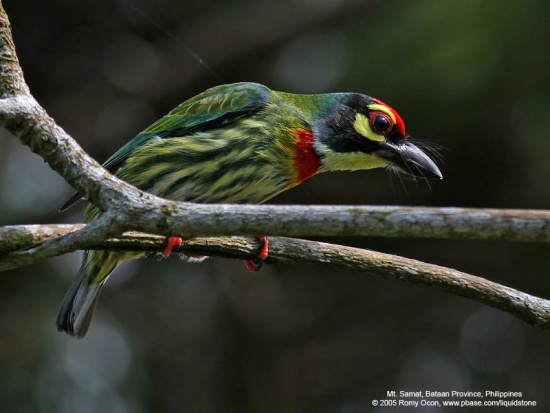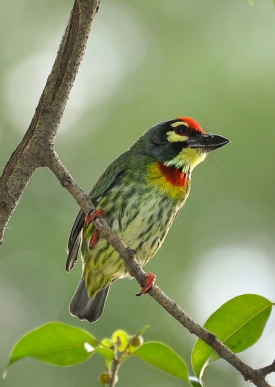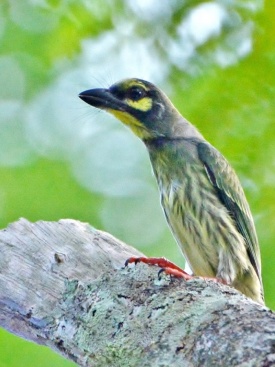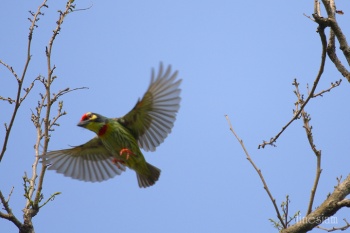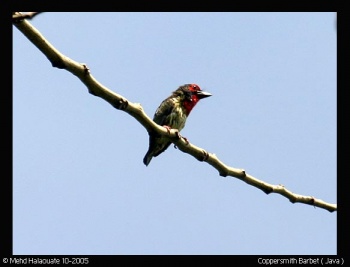Aloktewari (talk | contribs) (Sound file added) |
(References updated) |
||
| Line 62: | Line 62: | ||
Typical call recorded in my Urban home-garden, with occasional background sounds of Indian Robin and Laughing Dove. | Typical call recorded in my Urban home-garden, with occasional background sounds of Indian Robin and Laughing Dove. | ||
==References== | ==References== | ||
| − | #{{Ref- | + | #{{Ref-Clements6thAug16}}#BF Member observations |
{{ref}} | {{ref}} | ||
==External Links== | ==External Links== | ||
Revision as of 23:10, 14 September 2016
- Psilopogon haemacephalus
Identification
Smallest barbet at 15–17 cm (6-6¾ in)
The dark, stout bill is fringed with bristles or barbs, which give the barbets their name.
- Brightly coloured head with red forehead and forecrown, black eyestripe and moustache and yellow above and below eye, separated from green nape by black band
- Yellow chin and throat with red patch on lower throat and upper breast
- Bright green upperparts
- Greenish white underparts with diagnostic bold green streaks
- Red legs and feet
- roseus, homochroa, intermedius and cebuensis have red above and below eye instead of yellow and a red throat
Sexes similar, females have less bright red.
Distribution
The most common and widespread of the barbets found in India, through south China and South-east Asia through Sumatra, Java, Bali and the Philippines.
Widespread and common in its range, has adapted to man-altered habitats easily. Has colonized many areas due to forest clearance and logging, eg. peninsular Malaysia in the 1930s, arriving in Singapore in 1957.
Taxonomy
Formerly placed in the genus Megalaima.
Subspecies
9 subspecies recognized[1]:
- M. h. indicus:
- P. h. delicus:
- P. h. roseus:
- P. h. haemacephalus:
- Northern Philippines (Luzon and Mindoro)
- P. h. intermedius:
- Philippines (Guimaras, Negros, Panay, Calagayan, Pan de Azucar)
- P. h. celestinoi:
- Philippines (Samar, Leyte, Biliran and Catanduanes)
- P. h. mindanensis:
- Mindanao (southern Philippines)
- P. h. cebuensis:
- Cebu (central Philippines)
- P. h. homochroa:
- Philippines (Masbate, Romblon and Tablas); possibly Palawan
Habitat
Mangroves edges, open country, wooded gardens even town parks and cities
Behaviour
Perches on bare branches or high tension wires, in groups, often up to six.
Diet
Unlike its larger congeners it does not always frequent the canopy but will often feed low on small fruits in tree and brushs. Prefers Banyan, Peepul, and other wild figs, various drupes and berries, with the occasional insect, caught clumsily in flight.
Flight
Their flight action is straight with rapid wing beats.
Breeding
The breed from November to June, mainly from February to April.
The nest is in a hole, excavated in a decaying or dead tree or branch, about 40 cm deep. There are 2-4 white eggs, usually 3, laid on the bare wood. The length of incubation is not known. Both partners help with nest duties.
Vocalisation
Call is a loud, rather metallic tuk tuk tuk (or tunk), sounding rather like a copper sheet being beaten, which accounts for its name.
The call is repeated monotonously for long periods, beginning with a subdued tuk and then building up to an even tempo and volume, the former varying from 1.5 to 2 per second. The bill stays shut during each call and a patch of bare skin either side of the throat inflates and deflates with each tuk call. Body and tail shaking accompanies the calling.
The birds are not very vocal in cold weather, so they are silenced by a spell of rain or cold.
In India, this bird's call is one of the most familiar sounds in the hot season.
<flashmp3>coppersmith_barbet_alok.mp3</flashmp3>
Listen in an external program
Recording by Alok Tewari
Faridabad, Haryana, India, Sep.-2016
Typical call recorded in my Urban home-garden, with occasional background sounds of Indian Robin and Laughing Dove.
References
- Clements, J. F., T. S. Schulenberg, M. J. Iliff, D. Roberson, T. A. Fredericks, B. L. Sullivan, and C. L. Wood. 2016. The eBird/Clements checklist of birds of the world: v2016, with updates to August 2016. Downloaded from http://www.birds.cornell.edu/clementschecklist/download/
- BF Member observations
Recommended Citation
- BirdForum Opus contributors. (2024) Coppersmith Barbet. In: BirdForum, the forum for wild birds and birding. Retrieved 26 April 2024 from https://www.birdforum.net/opus/Coppersmith_Barbet
External Links




